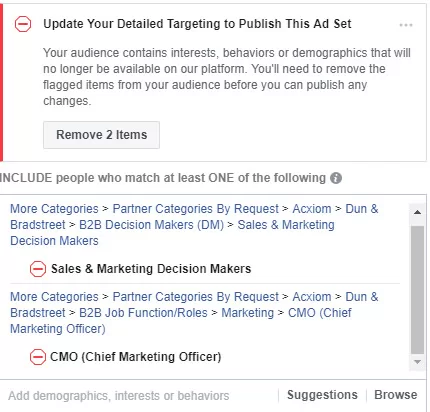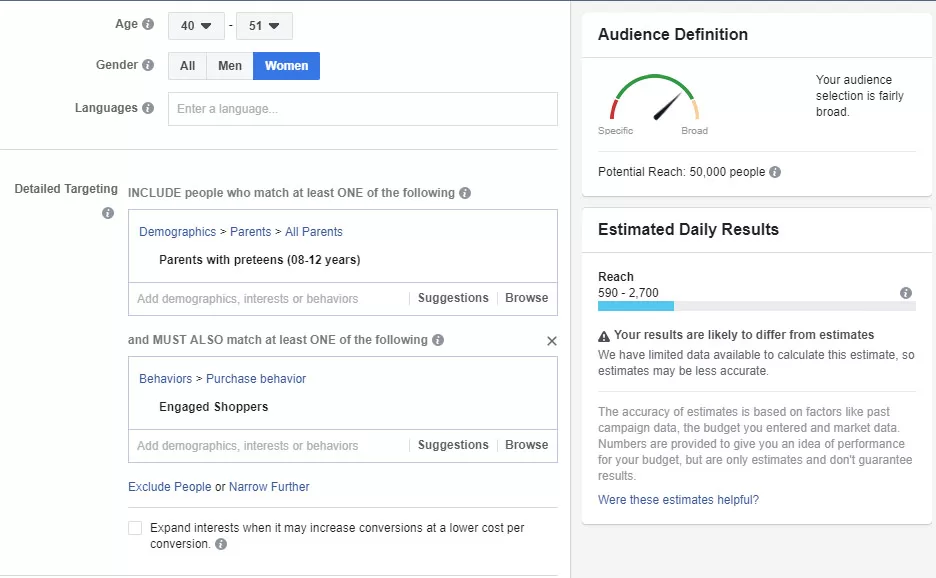Table of Contents
Recent Facebook data broker notifications and headlines have some marketers in a frenzy worrying that the best and most precise targeting options are going to disappear. Business owners and marketers are worried that carefully crafted campaigns will suddenly dip into the red and Facebook/Instagram will no longer be a viable platform for their products.
The headlines are concerning:


Facebook’s Data Broker notifications haven’t helped calm the storm.

Extremely detailed targeting options came from third party data providers. In 2013, Facebook launched partner categories powered by Datalogix, Epsilon, and Acxiom. They effectively allowed more targeting based on location, online purchasing, and browsing histories. Targeting using data from the wider web was a big progression from Facebook’s existing advertising audience options. They introduced some incredibly new granular targeting capabilities. You now had the ability to target people based on their previous credit card purchases. During this time period, marketers were ecstatic and Facebook produced some very large case studies to lure the largest advertisers to the platform.
Facebook was previously largely reliant on user information to target ads on its site. i.e. A user liked the Miller Lite Page. A user added Animal House as a favorite movie to their profile.
With this new data, you were suddenly able to target people who purchased craft beer at the grocery store (we used the feature to market a beer festival for one of our clients).
We have even used this type of data to market Matchnode. Take a look at the extremely specific audiences and equally scary Facebook data broker notifications below:

Why is Facebook Removing Data Broker Targeting?
There are multiple issues happening at Facebook that deal with both practical law and public perception. One is the Cambridge Analytica Scandal that created both philosophical as well as legal issues with the way Facebook has treated users’ data. As many as 87 million people may have had their information misused. Their information was initially gathered from a popular quiz back in 2014. It was continuously used in various methods that violated Facebook’s Terms of Service for political purposes. Some believe it may have influenced the results of the 2016 election.
The second factor fueling this change is GDPR. The General Data Protection Regulation went into effect May 25, 2018. This broad regulation is aimed at ensuring people have control over their personal data and that companies gain explicit consent for data collection and sharing from users, among other things. GDPR will apply to all companies that process personal data of EU citizens, regardless of where they reside. That means it applies to US companies that process data of EU citizens, whether they live in the States or elsewhere. Violators could be fined up to 4 percent of their company’s global revenue.
Add in the worry about Fake News and Facebook’s role in future elections, and the result is a general problem that public opinion is worried about the safety of their data on the e-platform.
One of the very first moves Facebook did to combat this public perception was to announce the sunset of data broker targeting options. Taking a proactive role and eliminating some targeting options that might seem “creepy” makes perfect sense.
Why You Shouldn’t Worry about Facebook Data Broker Notifications
As an agency that focuses on paid social ads, you might think we are worried about losing clients due to sudden disruptions in our CPMs and cost per actions on Facebook. In fact, we aren’t worried in the slightest.
Why? Because Facebook Lookalike Audiences are More Efficient than Data Broker Demographic Targeting for three main reasons: Cost, Audience Accuracy, and Size.
For the past 2 years, we have relied almost exclusively on Facebook lookalike audiences. Our informal research shows that campaigns/ad sets built from lookalikes have CPAs about 40% lower than targeting reliant on third party data. There are several reasons why we believe lookalikes perform better in most instances.
The first issue is easy to understand. The audiences from Data Brokers cost Facebook money and that was passed to the advertiser in terms of a premium CPM.
The second piece is accuracy. Remember that in 2013 when partner categories were introduced, the Facebook pixel was not spread across the web and mobile apps. The pixel allows Facebook to more effectively pull in more precise user data in real time. This data is far better than getting it from a third party data provider. Intelligently built lookalike audiences encompass the exact same targeting habits at scale, yet at the same time incorporate filters and properties hidden within the black box of Facebook’s algorithm. While that might sound scary, the results are the opposite. Lookalikes built from real-time pixel and engagement data are far more dynamic and effective than using data broker targeting.
Finally, there is scale. Also, remember that data broker targeting doesn’t necessarily mean you have targeted an entire audience of potential buyers. A one percent lookalike in the United States is 2.1 million people. A five percent lookalike is 10.8 million people. By targeting much larger audiences, you are able to scale and maintain profitable campaigns. When you start out with a much larger group, the algorithm is able to pinpoint people in real-time during buying moments.
Let’s take a look at an easy example. Many businesses are uncomfortable with the idea of building lookalike audiences and not layering on additional user information. They believe they know their customer and want the precision available from Facebook to hyper-target their ads (this is exactly what Matchnode used to do in our early days). The problem with this strategy is you often end up with audiences that are way too small to effectively target at scale.
Since the audience size is too small, your frequency rises quickly, and your click-through rates begin to drop. Soon your CPMs and CPCs rise and your ad relevance scores drop. You are also unable to use the Facebook algorithm to market to the audience when they are most likely to convert. What was an effective campaign, is no longer profitable, and volume was out of the question from the start.
Our belief is that this happens at scale across the platform when multiple users are reliant on the same types of filters. Too many advertisers targeting the same people. Take a look at the below audience.
- Women aged 40-51
- Parents of preteens aged 8-12 years old
- Live in Wisconsin, Iowa, Illinois, Minnesota, Iowa or Michigan
- Are Engaged Shoppers

That might seem like the absolute perfect audience for a retailer trying to sell to a teen through their parents; however, the estimated audience is only 50,000 people. Our rough estimate is that size of an audience could support a budget of only about $50/ daily.
Audience size is also extremely important to take full advantage of the Facebook Algorithm and Learning Phase. Facebook ads need about 50 conversions to learn just who and how to optimize for the lowest cost conversion. The algorithm adjusts the targeting on the fly based on the attributes of what is working. The power of the “Learning Phase” cannot be emphasized enough. You need large audiences to make this work.
The main takeaway is that it is much easier to scale Facebook campaigns with lookalike and retargeting audiences. You are simply able to more accurately target people at scale, in real-time. You never have to refresh your custom audiences, as the pixel takes care of that for you. Facebook’s algorithm is able to adjust based on who is looking at your ads and taking the next step towards conversion. By using custom and lookalike audiences, it is possible to reach your ideal customers on Facebook without the use of third-party data.